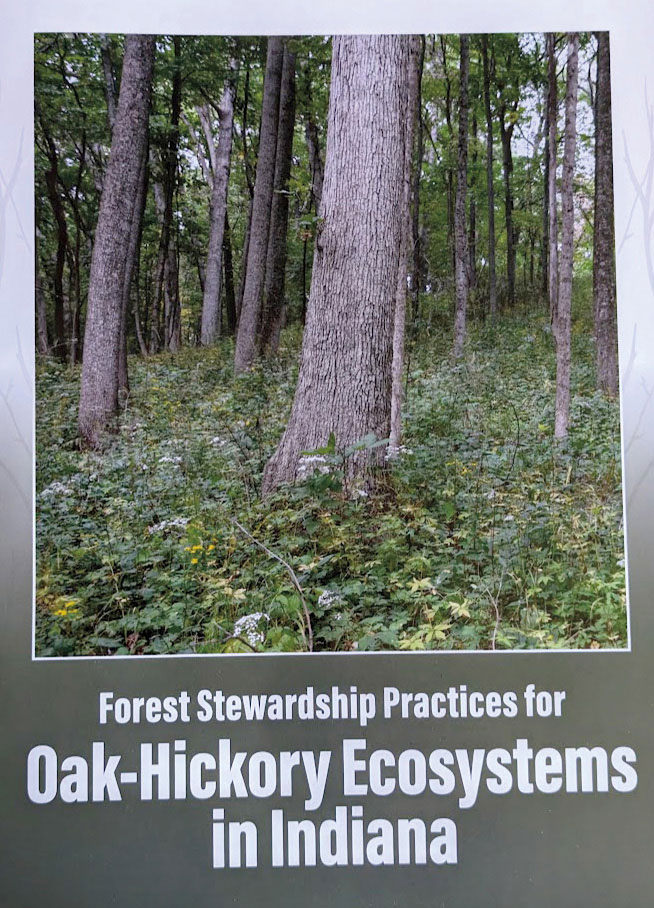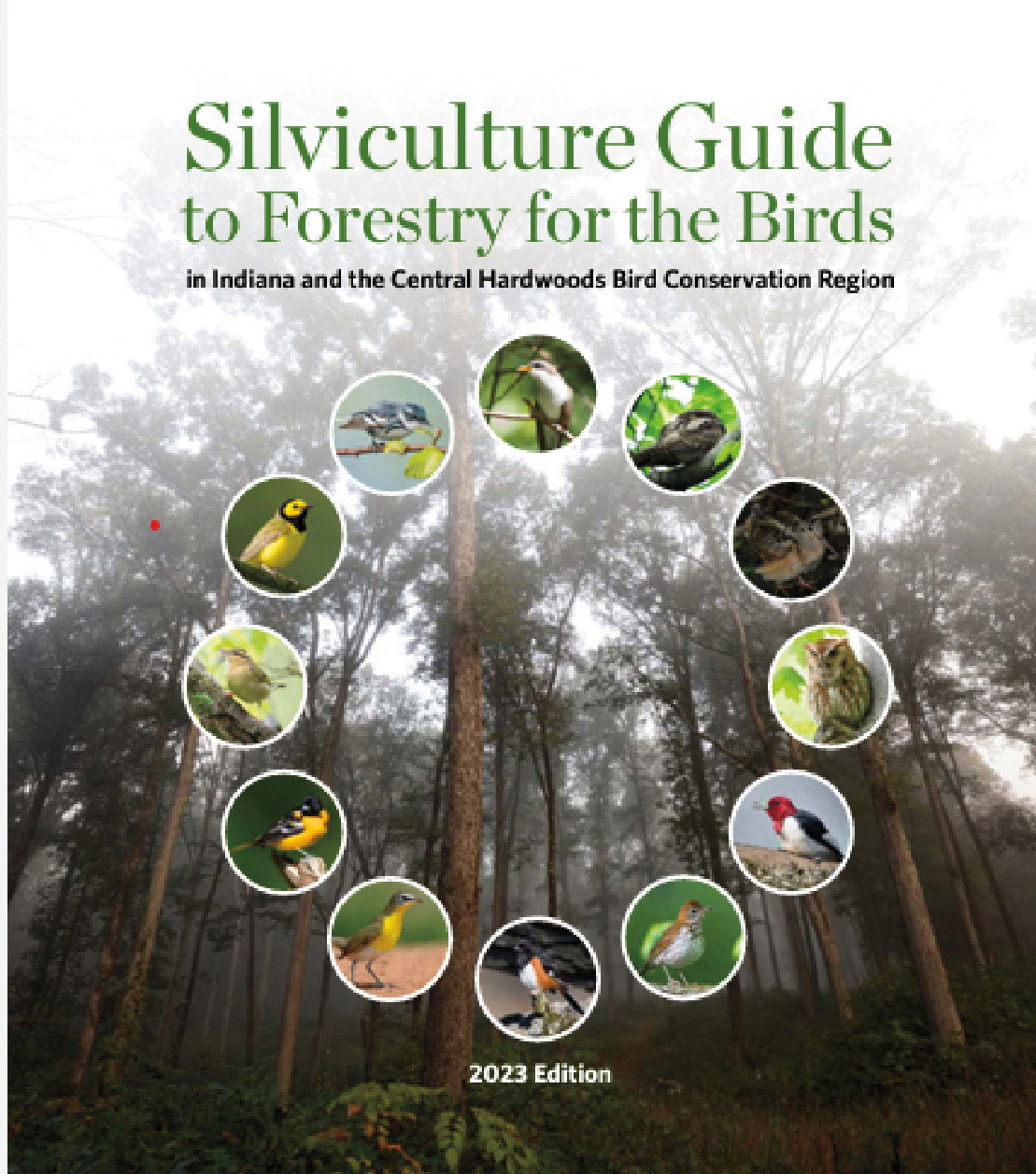Forest Management is for the Birds!
Indiana forest owners keep their goals in mind as they manage their forests. Management goals vary across the spectrum, and can include habitat improvements to benefit wildlife and improve hunting opportunities. Another goal is recreation, including hiking or ATV trails for the enjoyment of the forest owners; or income, using management to improve the quality of the timber. For most forest owners, their goals include a combination of the above, plus several more. And management methods utilized can achieve multiple goals. Managing for wildlife and hunting can also benefit songbirds, timber value, and recreation opportunities. Forest managed for profit still incorporate wildlife and bird friendly practices. All of the management strategies utilized have long-term effects across the entire forest ecosystem.
Regular readers of newsletters such as the Indiana Forestry and Woodland Owner’s Leaves and Limbs have heard the statistics about the alarming loss of songbird populations around the world. Since 1970, long-term surveys reveal a net loss of 2.9 billion birds in North America. (Science, https://www.science.org/content/article/three-billion-north-american-birds-have-vanished-1970-surveys-show). Conversations among bird watchers include nostalgia for the birds they no longer see or hear, including Eastern Whip-poor-will, Eastern Screech-owl, Red-Headed woodpecker, Wood Thrush, and Cerulean Warbler, among others. But if you live near a well-managed forest, you may be a little surprised by these conversations. The late winter evening air near a forest opening will include the sights and sounds of the woodcocks doing their mating dance. Summer mornings will be filled with the flute-like song of the Wood Thrush, and the evenings with a chorus of “whip-poor-will, whip-poor-will!”. So, what is attracting the birds to these areas? Why are the number of birds across North America declining, yet they are seen and heard near our managed forests? The key word here is “managed”.
The Changing Forest Composition
Our public forest land is managed for the long term by professional foresters, using the most current science. The foresters managing these properties began noticing changes in the forest composition over recent decades. Areas that were typically oak forests in the 1980’s have slowly converted into forests composed of beech and maple trees, and oak trees are no longer successfully regenerating. Research is being done across the Central Hardwoods Region by universities, and, in Indiana, studies are conducted at projects such as the Hardwood Ecosystem Experiment (heeforeststudy.org). The research reveals that continuing to utilize the existing management strategies results in our forest stands becoming more shaded, and forest composition is changing to species that thrive in shaded, moist forests, such as American beech and Sugar maple. This habitat change is part of why songbird populations are in decline.
 Let the Sun Shine In: Keeping a Mosaic of Forest Types on the Landscape
Let the Sun Shine In: Keeping a Mosaic of Forest Types on the Landscape
In response, public forest managers have followed the research and are carefully managing forest stands to allow more sunshine to reach the forest floor. Disturbances to forest canopies, such as regeneration openings, offer opportunities for our sun loving species, such as oak and hickory trees, to receive adequate sunlight to regenerate and grow. Our public forests now utilize a variety of management strategies that encourage a diverse mix of ecosystems, including the more shaded beech-maple ecosystem and the more sun loving oak-hickory ecosystem. This provides a diversity of forest types: young and old, shaded and open, brushy, and tall and straight. This diversity of food and shelter sources has allowed the songbirds, and wildlife in general, to thrive.
According to the Indiana Division of Forestry’s webpage, approximately 162,000 private landowners own approximately 77% of the 4.7 million acres of timberland in Indiana. (Source: Forest Inventory and Analysis Data 2019). In 2018, 3.6 million acres were in private ownership, leaving only approximately 13% of the timberland in public ownership. The time has come for private forest landowners to continue, or begin, to manage their forests for a diversity of ecosystems across the landscape to support our birds! If our management strategy is not “for the birds”, the decline in our oak-hickory ecosystem and songbird populations will continue.
Resources Are Available
Luckily for the birds, there are resources available to private forest landowners to assist them with their management objectives. One is available through Indiana’s Let the Sun Shine In collaboration. Let the Sun Shine In (LSSI) formed in response to the mesophication, or transition of our oak-hickory ecosystems to more mesic beech-maple ecosystems across Southern Indiana. The collaboration of private and public forestry organizations formed to share the message: if Indiana forestland owners do not follow the science, the oak-hickory ecosystem will continue to disappear, and as a result, our songbird populations will continue to decline. Over 950 caterpillar species rely on our oak trees as their primary food source (National Wildlife Federation, Power Plants, 4-1-22), making oak trees a keystone species. Removing oak trees from an ecosystem removes the food source for scores of wildlife, and this reverberates through the whole food web.
Let the Sun Shine In Stewardship Guide
A meaningful action that all forest landowners can make is to support the oak-hickory ecosystem, increasing the biodiversity of plants and animals to the benefit of everyone across the state. To this end, LSSI has introduced a guide called Forest Stewardship Practices for Oak-Hickory Ecosystems in Indiana. The District Foresters across Indiana have electronic copies of this guide that they can provide to the landowners in their districts. Printed copies are also available through the District Foresters’ Offices across Indiana, and the electronic copy will soon be available on the LSSI collaboration’s website. This guide details management strategies that forest landowners can employ in their forests to keep the oak-hickory ecosystem across the Indiana landscape.
Assistance from IDNR District Foresters
The Indiana Division of Forestry now has 20 District Foresters (https://indnr.maps.arcgis.com/apps/instant/basic/index.html?appid=481c67efabab4b40893fff263494e8f9) to assist landowners. District Foresters are available to visit private landowners’ woods and recommend the best course of action to meet their goals. The District Foresters can advise landowners about state and federal programs that provide technical assistance, property tax incentives, and cost-sharing incentives to assist them with their management strategies.
Forestry for the Birds
Another tool in a landowner’s forest management toolbox is the Forestry for the Birds program, found on The Nature Conservancy’s website, /https://www.nature.org/content/dam/tnc/nature/en/documents/Forestry-for-the-Bird-Pocket-Guide-April2022.pdf. Forestry for the Birds materials include a pocket guide for landowners in Indiana, which details twelve different bird species, including fun facts about the species, where they nest, how to identify them by their song, and management tips to provide habitat for them in your forest.
A companion document is also found on The Nature Conservancy’s website, called Silviculture Guide to Forestry for the Birds (https://www.nature.org/content/dam/tnc/nature/en/documents/TNC-Forestry-for-the-Birds-Silviculture-Guide.pdf). This guide goes into more detail about the management practices a landowner can utilize on their forests to benefit the birds, and the entire ecosystem.
Indiana’s forest land owners are in a great position to continue to work with their foresters on the best management strategies for their forested land. Not all forest land is suited to be oak-hickory ecosystems. But it is up to all of us to manage our forest land across the entire landscape, help the oak-hickory ecosystem to thrive, and utilize forestry management practices that are for the birds.
Judi Brown works for the American Bird Conservancy as coordinator for Let the Sunshine In - Indiana. Her role is to provide education and outreach opportunities for landowners regarding forest management strategies that encourage the growth of oaks and hickories in our forests.

